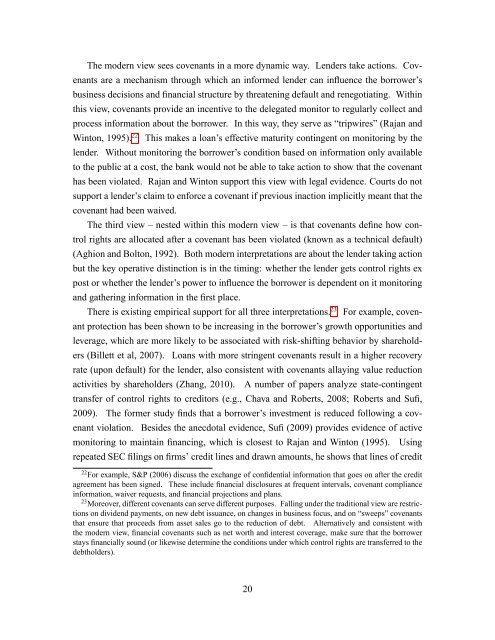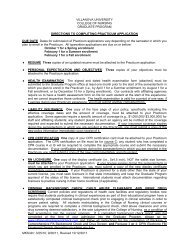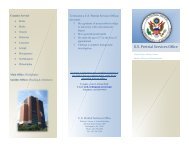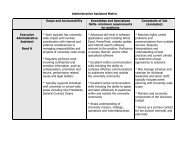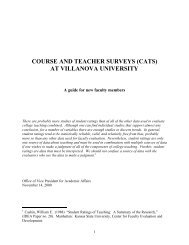Lender Exposure and Effort in the Syndicated Loan Market.pdf
Lender Exposure and Effort in the Syndicated Loan Market.pdf
Lender Exposure and Effort in the Syndicated Loan Market.pdf
Create successful ePaper yourself
Turn your PDF publications into a flip-book with our unique Google optimized e-Paper software.
The modern view sees covenants <strong>in</strong> a more dynamic way. <strong>Lender</strong>s take actions. Covenantsare a mechanism through which an <strong>in</strong>formed lender can <strong>in</strong>uence <strong>the</strong> borrower'sbus<strong>in</strong>ess decisions <strong>and</strong> nancial structure by threaten<strong>in</strong>g default <strong>and</strong> renegotiat<strong>in</strong>g. With<strong>in</strong>this view, covenants provide an <strong>in</strong>centive to <strong>the</strong> delegated monitor to regularly collect <strong>and</strong>process <strong>in</strong>formation about <strong>the</strong> borrower. In this way, <strong>the</strong>y serve as “tripwires” (Rajan <strong>and</strong>W<strong>in</strong>ton, 1995). 22This makes a loan's effective maturity cont<strong>in</strong>gent on monitor<strong>in</strong>g by <strong>the</strong>lender. Without monitor<strong>in</strong>g <strong>the</strong> borrower's condition based on <strong>in</strong>formation only availableto <strong>the</strong> public at a cost, <strong>the</strong> bank would not be able to take action to show that <strong>the</strong> covenanthas been violated. Rajan <strong>and</strong> W<strong>in</strong>ton support this view with legal evidence. Courts do notsupport a lender's claim to enforce a covenant if previous <strong>in</strong>action implicitly meant that <strong>the</strong>covenant had been waived.The third view – nested with<strong>in</strong> this modern view – is that covenants dene how controlrights are allocated after a covenant has been violated (known as a technical default)(Aghion <strong>and</strong> Bolton, 1992). Both modern <strong>in</strong>terpretations are about <strong>the</strong> lender tak<strong>in</strong>g actionbut <strong>the</strong> key operative dist<strong>in</strong>ction is <strong>in</strong> <strong>the</strong> tim<strong>in</strong>g: whe<strong>the</strong>r <strong>the</strong> lender gets control rights expost or whe<strong>the</strong>r <strong>the</strong> lender's power to <strong>in</strong>uence <strong>the</strong> borrower is dependent on it monitor<strong>in</strong>g<strong>and</strong> ga<strong>the</strong>r<strong>in</strong>g <strong>in</strong>formation <strong>in</strong> <strong>the</strong> rst place.There is exist<strong>in</strong>g empirical support for all three <strong>in</strong>terpretations. 23For example, covenantprotection has been shown to be <strong>in</strong>creas<strong>in</strong>g <strong>in</strong> <strong>the</strong> borrower's growth opportunities <strong>and</strong>leverage, which are more likely to be associated with risk-shift<strong>in</strong>g behavior by shareholders(Billett et al, 2007).<strong>Loan</strong>s with more str<strong>in</strong>gent covenants result <strong>in</strong> a higher recoveryrate (upon default) for <strong>the</strong> lender, also consistent with covenants allay<strong>in</strong>g value reductionactivities by shareholders (Zhang, 2010).A number of papers analyze state-cont<strong>in</strong>genttransfer of control rights to creditors (e.g., Chava <strong>and</strong> Roberts, 2008; Roberts <strong>and</strong> Su,2009). The former study nds that a borrower's <strong>in</strong>vestment is reduced follow<strong>in</strong>g a covenantviolation.Besides <strong>the</strong> anecdotal evidence, Su (2009) provides evidence of activemonitor<strong>in</strong>g to ma<strong>in</strong>ta<strong>in</strong> nanc<strong>in</strong>g, which is closest to Rajan <strong>and</strong> W<strong>in</strong>ton (1995).Us<strong>in</strong>grepeated SEC l<strong>in</strong>gs on rms' credit l<strong>in</strong>es <strong>and</strong> drawn amounts, he shows that l<strong>in</strong>es of credit22 For example, S&P (2006) discuss <strong>the</strong> exchange of condential <strong>in</strong>formation that goes on after <strong>the</strong> creditagreement has been signed. These <strong>in</strong>clude nancial disclosures at frequent <strong>in</strong>tervals, covenant compliance<strong>in</strong>formation, waiver requests, <strong>and</strong> nancial projections <strong>and</strong> plans.23 Moreover, different covenants can serve different purposes. Fall<strong>in</strong>g under <strong>the</strong> traditional view are restrictionson dividend payments, on new debt issuance, on changes <strong>in</strong> bus<strong>in</strong>ess focus, <strong>and</strong> on “sweeps” covenantsthat ensure that proceeds from asset sales go to <strong>the</strong> reduction of debt. Alternatively <strong>and</strong> consistent with<strong>the</strong> modern view, nancial covenants such as net worth <strong>and</strong> <strong>in</strong>terest coverage, make sure that <strong>the</strong> borrowerstays nancially sound (or likewise determ<strong>in</strong>e <strong>the</strong> conditions under which control rights are transferred to <strong>the</strong>debtholders).20


